
Tell us what you need to find a matching loft conversion specialist

Get free quotes from professionals near you

Compare offers and choose the one that best matches your need
- Householdquotes.co.uk
- Home Insulation
House Insulation in The UK - 2025 Guide

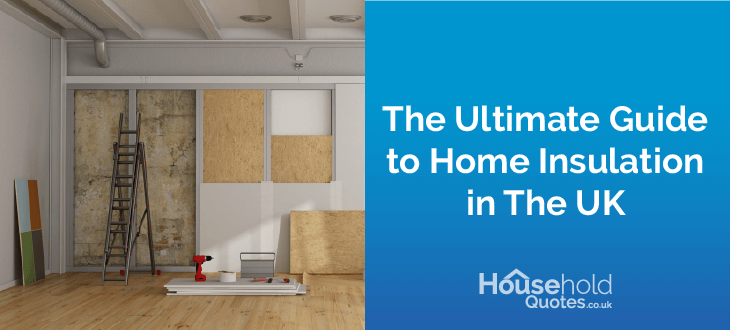
- UK homes rated F on the Energy Performance Certificate (EPC) scale can pay up to £1,000 more on annual heating compared to C-rated homes.
- Homes with insulated walls, floors, and lofts can save up to £630 - £730 on annual energy bills.
- Complete home insulation can potentially cut your annual carbon emissions by 1.4 to 1.7 tonnes.
Energy prices across the UK have skyrocketed over the past years as homeowners grapple with rising costs of living. More often than not, the culprit for these soaring energy bills is draughty homes and poor insulation, reflected by home energy systems that run overtime in an attempt to top up the constant heat loss. Luckily, effective home insulation is an eco-friendly and long-term solution to bolster your home's energy efficiency whilst saving you lots of money.
Here are just some of the incredible benefits you could experience with proper home insulation:
- Slash energy bills: Proper home insulation can cut down your heating costs significantly. Insulating your walls and loft can reduce nearly 60% of the heat loss your home experiences, saving up to £650 on your annual energy bills.
- Reduce carbon footprint: UK homes emit more CO2 in a single year than all of the country's cars combined. This means staying home creates a larger carbon footprint than driving! With floor, wall, and loft insulation, a household can reduce its carbon footprint by up to 1.7 tonnes every year.
- Improve home health: Poorly insulated homes breed dampness, draft, structural rot, and mould, all of which pose a serious risk to your home and personal health, eventually leading to costly maintenance and medical bills. Mould also increases the risk of respiratory issues and illness.
- Increase property value: Insulation gives your home an energy upgrade, reflected in a higher Energy Performance Certificate (EPC) rating. This makes your investment far more valuable on the housing market and attractive to potential renters and buyers.
If you’ve wondered how to prevent heat loss in a house while saving yourself more money, our complete guide on home insulation will walk you through everything you need to know. Read on for information on how to insulate your home, the expected costs, available government grants, and the best insulation materials the market has to offer.
Already eager to start insulating your home? Finding the right installer for the job can be harder than it seems. Instead of spending hours on websites and calls, look no further than Household Quotes UK to take care of it all for you.
Simply fill out our 30-second form, and receive 3 free home-tailored quotes from our network of trusted local installers; completely free of obligations. Get ahead of the competition with the best bargains and ensure your home receives the treatment it deserves.
- Describe your needs
- Get free quotes
- Choose the best offer
It only takes 30 seconds



Prevent heat loss by insulating your house
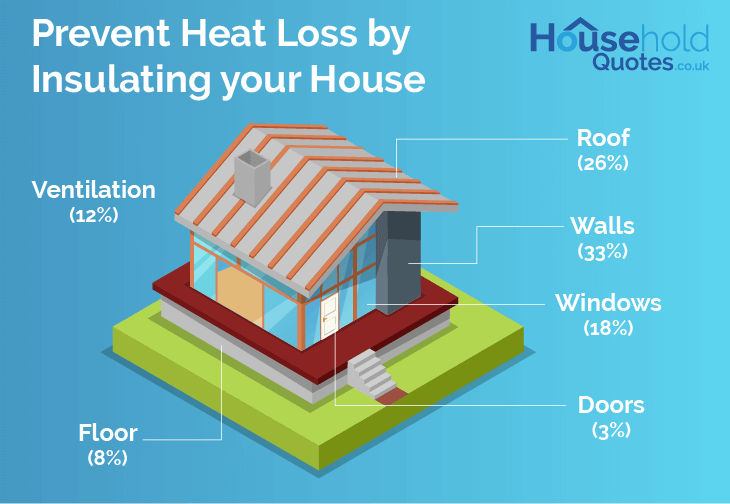
According to a 2020 study by intelligent home climate management firm Tado, poor insulation results in UK homes losing domestic heat up to three times faster than some European neighbours. This is reflected in soaring energy bills and fuel poverty.
The largest contributors are poorly insulated walls and roofs, accounting for nearly two-thirds of a home's heat loss. Draught-prone windows and doors, uninsulated floors, and ventilation shafts further contribute to this heat loss in homes.
If you want to know how to reduce heat loss in a house, you first need to know that each home will likely have different shortcomings and insulation needs. Identifying where your home stands can help ensure you invest in the insulation that benefits you the most.
Contacting a professional energy auditor in your area is a good step to take. They can conduct a home survey to determine whether your existing heat insulation is up to standard, and suggest home improvements based on the assessment.
Homes also come with an Energy Performance Certificate (EPC) rating that tells you the current efficiency of your home. An EPC rating is valid for up to 10 years, and it is strongly recommended to conduct a new assessment if this period passed. An EPC assessment costs between £60 - £120 depending on the provider, and can even give you tailored home insulation advice.
Ways to insulate your home
This section will break down the host of options in which your home's energy efficiency can be improved through insulation. These upgrades will save you hundreds in annual energy bills, positively serve the planet, and bolster your property value on the housing market.
To give you a rounded understanding, here is a full cost and saving breakdown for each avenue of home insulation you can implement:
| Insulation type | Costs | Energy bill savings (£/year) | CO2 savings (kgCO2/year) |
|---|---|---|---|
| Cavity wall (270mm) | £2,700 | £280 | 650 |
| Solid wall (internal) | £7,500 | £380 | 880 |
| Solid wall (external) | £12,000 | £380 | 880 |
| Floor (suspended timber) | £4,700 | £80 | 185 |
| Loft | £930 | £270 | 620 |
| Windows | < £15,000 | £165 | 375 |
| Doors | £840 – £4,325 | £45 | - |
| Pipes and Water Tank | £38 | £226 | 715 |
Beyond bigger insulation projects, there are many easy and affordable heat-saving tips you can implement to make your home warmer. Draught-proofing your doors and windows, sealing off openings, or adding thermal curtains are some examples of simple tricks that go a long way.
Roof and loft insulation

Proper roof and loft insulation can slash your annual energy bills by up to £270, as well as reduce your carbon footprint by around 0.6 tonnes. Loft insulation costs sit at around £930. Up to a quarter of your home’s heat is prone to escaping just through the roof or loft.
More than just savings, roof, loft, or attic insulation boasts a quick payback period of just over 3 years, ensuring decades of energy and financial security to come.
If you’re wondering how to insulate a loft, the first step is figuring out what it’ll be used for. When insulating for storage or living space, there are different steps to take:
- Loft for storage: If you don't plan to live in the loft, simply insulating the loft floor will be enough to keep your house warm. This can be done DIY, but a professional installer is always recommended. The loft floorboards are lifted and elevated with loft legs attached to the joists. Then, 270mm mineral wool is laid between the joists, with a 50mm air gap for ventilation between the material and floorboards. Generally, the best loft insulation material for this job is standard (blanket) variants.
- Loft for living: The job is more complex if you want to use your loft as a living space. It is not recommended to do this DIY to make sure the job is up to standard. In addition to the loft floor, the inner walls of your loft living space will also require insulation to make sure heat doesn’t escape to uninsulated parts of your loft. Any windows or skylights will also require quality glazing for the best results. Consulting with a licensed professional installer ensures the job is done correctly.
Joists are the structural beams found supporting floors and ceilings, which are usually horizontal.
Rafters are the structural beams that support the roof structure and are usually vertical.
UK homes tend to come in 2 different styles; traditional pitched roofs, and flat roofs. If you want to insulate the roof directly, there are several options depending on the style of roof you have, and whether your home has a loft or not:
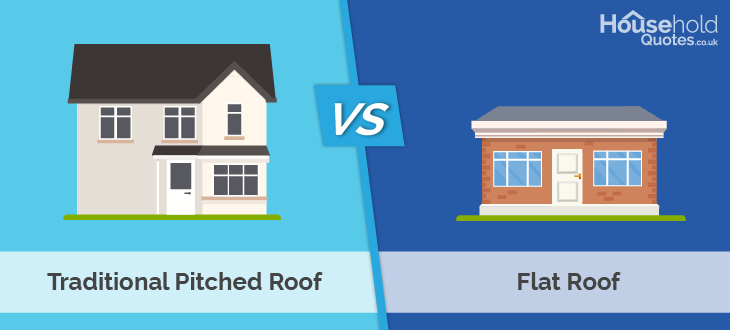
For traditional pitched roof insulation, sometimes called sloping roofs, there are 2 main approaches to insulating from the inside; warm roof insulation (above and between the rafters), or cold roof insulation (between and below the joists of your loft floor).
Each style of insulation has its factors to consider:
| Features | Warm roof insulation | Cold roof insulation |
|---|---|---|
| Placement | Directly under the roof from the inside. Insulation is placed above and between the rafters of the roof. | Insulation is placed over and between the wooden joists of your loft floor, but not the roof. |
| Temperature | Insulates your entire loft area, ensuring warmth in the winter. Ideal for living space. | Leaves the loft uninsulated but the rest of your house warm. Ideal for storage. |
| Ventilation | Ventilation is required right below the roof tiles to prevent rot and condensation build-up. Professional installer highly recommended. | Ventilation is needed, but more flexible and simple options are available. |
| Cost & installation | Generally a more expensive and complex installation. | Cheaper cost and simpler installation. |
For flat roofs, the same 2 methods of heat insulation still apply; warm roof insulation (insulation material placed above the roof deck, under the roofing material), or cold roof insulation (insulation material placed under the roof deck, between the rafters from the inside). Here is what you could expect for each option:
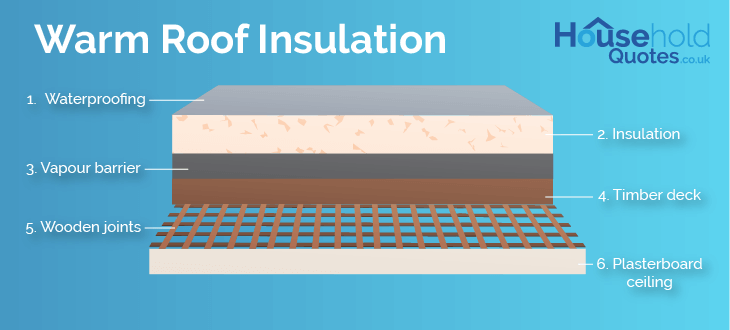
Warm roof insulation is when insulation - normally PIR (polyisocyanurate) boards - is added directly to the roof deck. It is added between a waterproof membrane on top and a vapour check layer underneath to make sure there’s no moisture build-up. Roofing material is then placed on top and secured in place.
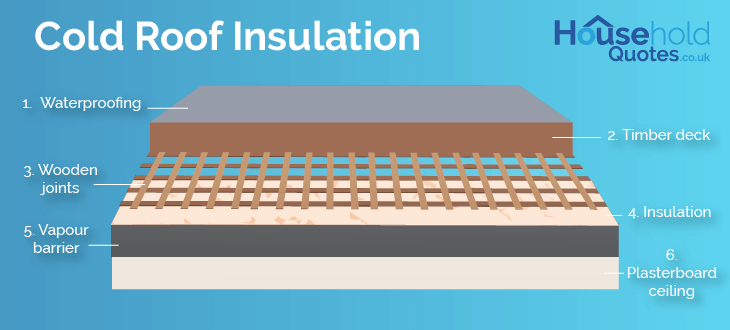
Cold roof insulation is a form of ceiling insulation when the insulation material - normally fibrous types such as mineral wool, fibreglass, or sheep’s wool - is added in between and over the rafters in the ceiling from the inside of the home. Then, a vapour check layer is added to ensure moisture doesn't enter the home, and the entire thing is covered with plasterboard or other ceiling material.
In both cases, a professional installer is almost always recommended to ensure the job is done professionally and up to regulations. A roof insulation cost can vary depending on your circumstances, so the best time to carry out flat roof insulation is during repairs and replacements to avoid unexpected costs and prolonged disturbance to your home life.
If loft insulation prices seem too high, there’s good news: you may qualify for a loft insulation grant via the Great British Insulation Scheme (formerly known as ECO+).
The government initiative aims to aid the least energy-efficient UK homes, tackling fuel poverty and lowering energy bills. From April 2023 to March 2026, eligible participants can get reduced cost or free insulation depending on the results of a property assessment.
Floor insulation
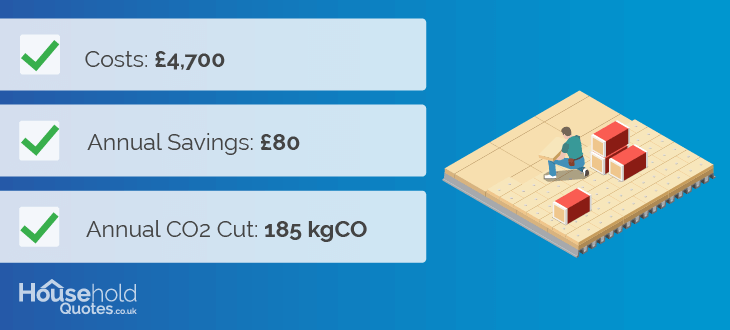
Having adequate underfloor insulation can save you up to £80 on annual energy bills. Around 8% of the heat produced in your home runs the risk of escaping through poorly insulated floors.
Here are the main 2 floor types found in the UK:
- Concrete floors are often found in newer UK homes. For concrete floor insulation, it's best to do so when replacing or repairing your floors. Insulation can be added underneath or by placing rigid PIR boards on top, which are then covered with new flooring material.
- Suspended timber floors are more typical in older UK homes. They consist of wooden floorboards laid on joists, which span the space above the building's foundation. This creates a gap underneath, allowing air to circulate and prevent floorboards from rotting.
You can identify suspended timber floors by looking for ventilation bricks on the outside walls of your home, just below ground level. If you have a cellar or basement, you might even see the wooden joists and floorboard undersides by looking up at your cellar ceiling.
Suspended timber floor insulation is relatively straightforward and cost-effective. Firstly, the floorboards are removed, and a fibrous insulator - such as mineral wool or fibreglass - is laid in between the joists. The insulation material is then secured with netting and the floorboards are added back on top. A professional installer is always recommended to ensure no air bricks or ventilation gaps are blocked, and that the job is carried out to the required standards.
Wall insulation
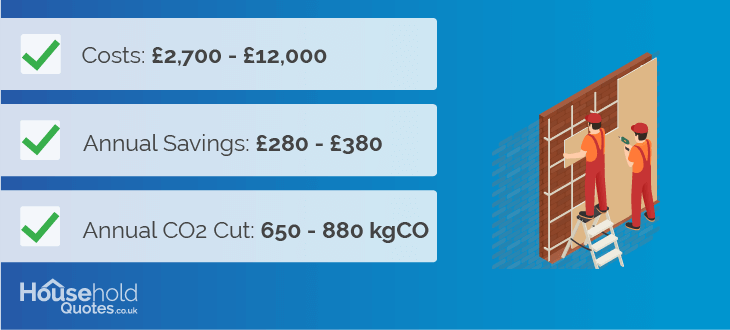
UK properties normally have two types of walls; cavity walls and solid walls. Both can be insulated, saving you £280 - £380 respectively on annual energy bills. More so, poor wall insulation is the culprit for a staggering one-third of your home's heat loss, causing higher home energy bills and CO2 emissions. Here is the difference between wall types:
- Homes built after 1920: These properties typically have cavity walls. These are two walls with a small air gap between them. This gap can then be filled with insulation, which helps keep your home warm and reduces energy bills. Nearly 3 in 10 cavity wall homes in the UK lack proper heat insulation, leading to heat loss and high energy bills.
- Homes built before 1920: These properties usually have solid walls, built with a single layer of bricks. While charming, a whopping 97% of solid wall homes in the UK have inadequate exterior wall insulation, causing sky-high energy bills for homeowners.
Cavity wall insulation is a relatively straightforward process that can be completed in just a few hours. Normally, a licensed professional injects foam-based insulation material - such as PUR (polyurethane) foam - into the wall through small holes drilled in the outer wall. Once done, the holes are sealed with cement and become hardly visible.
Solid wall insulation is a more complex and labour-intensive process that tends to cost more. Since there's no wall cavity, solid walls can only be insulated internally or externally. Here are the main differences:
- Internal wall insulation
This is done by fitting solid insulation boards directly on your home's inside walls and covered with plasterwork. In another approach, stud walls are built and stud wall insulation (such as mineral wool or other fibrous insulators) is added behind.
Internal insulation is cheaper to install, but it does slightly reduce your floor space.
- External wall insulation
External insulation by fixing insulating material to the outer walls, covered in plasterwork or cladding. Benefits include improved weatherproofing, sound isolation, and an undisturbed home during installation.
For external insulation, planning permission might be needed due to changes to the outer appearance.
Windows & doors
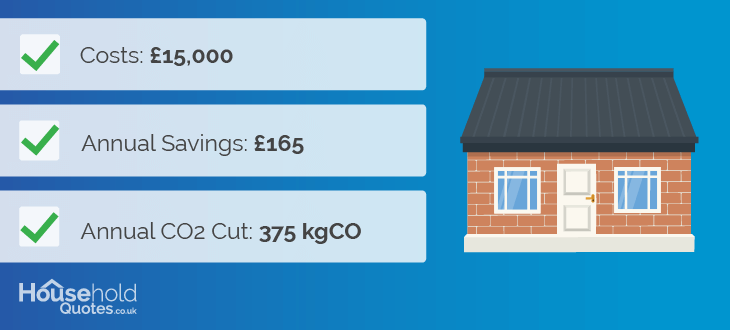
Insulated windows and doors can save up to £210 in combined annual energy savings. Single-glazed windows and draft-prone doors collectively account for around 18% of the heat loss in your home. Quality triple-glazed windows can cut your window heat loss by a remarkable 40 - 60%.
Double or triple-glazed windows have two or three panes of glass in a single unit, separated with pockets of air in between, acting as a heat and noise insulator. Higher-quality windows have pockets of gas (such as argon, xenon, or krypton), which have been proven to boost heat and sound insulation by a further 30% or more.
With doors, insulating and draught-proofing can make a big difference in your home's ability to retain heat. Modern doors often come with insulation built right into the frame, but there are plenty of ways to improve the insulation of older doors.
Here are some ways you can do just that:
- Side panel gaps: Seal the gaps on the sides and bottom of your door with draught-proofing strips for a cheap solution. These can be found in most local hardware stores.
- Bottom gap: Purchase a brush attachment, similar to those found in a letterbox, or a draught excluder strip to help seal this gap and better prevent draught.
- Keyhole: A simple metal disc cover can seal the keyhole and stop heat escaping.
- Letterbox: Seal the gap with a draught-proof strip or use a letterbox flap with a built-in brush to reduce heat loss.
As for internal doors within your home, they would only require draught-proofing if they lead to an unheated portion of your home, such as a garage or porch.
Piping insulation
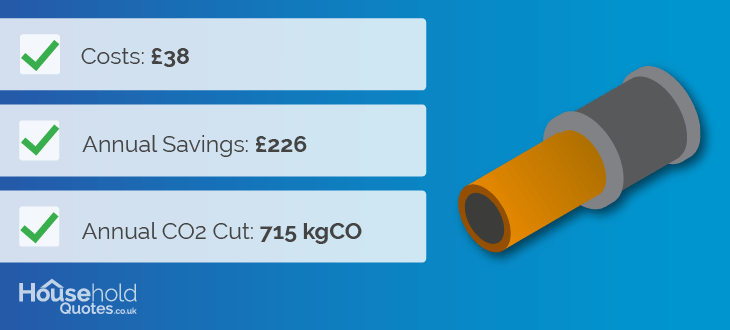
Insulating your ventilation shafts, radiators, water tanks, and even pipes is quite easy and very cost-effective, yet it can help you save up to £226 in combined annual energy savings whilst cutting your heat loss by up to 12%.
Here are some ways you can go the extra mile in house insulation:
- Radiators: Place reflector panels behind your radiators for better insulation. These affordable panels reflect heat into the room, preventing loss through external walls.
- Water Tank: Add a hot water cylinder jacket to your tank to preserve water heat for longer. These jackets cost as little as £20 and come with easy-to-follow instructions for a DIY installation.
- Pipes: To protect pipes from freezing, especially in outdoor areas during winter, you can use tube-shaped insulators made from materials like polyethylene foam, rubber, or foil tape. Cut and wrap them around your pipes for added efficiency.
What insulation materials should I use
Finding the perfect insulation material can seem overwhelming, but luckily there is a wide array of highly effective, versatile, and affordable options on the market to prevent heat loss in homes. Remember, the ‘best’ insulation material highly depends on your property type, the job, desired budget, and energy efficiency needs amongst other things.
Let's look at some of the most popular synthetic and natural insulation materials that are found on the market today:
- Fibreglass: Made from recycled glass, this soft and flexible material used to prevent heat loss is great for insulating roofs, floors, and internal walls. It comes in the form of sheets or batts and can also be sprayed into gaps and crevices, useful when insulating irregular shapes.
- Polyurethane (PUR) foam: This highly effective thermal insulation foam, applied with a spray gun, is perfect for sealing small gaps and cracks in roofs and floors. It's also often used for insulating cavity walls given its quick and easy application.
- Polystyrene: This rigid foam comes in sheets or blocks and offers excellent heat and noise insulation. Both expanded (EPS) and extruded (XEPS) options are available, with EPS being much lighter than XEPS. It's commonly used for wall insulation.
- PIR Board: This polymer-based insulator that is melt-proof comes in rigid boards or panels and is mainly used for insulating walls, floors, and ceilings.
- Mineral Wool: Made from melted glass or rock, this versatile and sustainable option comes in sheets or batts for walls, floors, and roofs. It can also be blown into small spaces like foam or cellulose insulation.
- Sheep's Wool: This 100% natural material is perfect for wall, floor, and roof insulation. Its unique texture traps air effectively and slows heat transfer no less than its synthetic counterparts. It's also renewable and sustainable, making it a great eco-friendly choice.
- Cellulose: Made from recycled paper products, cellulose is highly effective at preventing heat loss in walls and roofs. It's surprisingly even more efficient than fibreglass and can be blown into small spaces for complete coverage.
- Perlite: This volcanic mineral is processed with a far smaller environmental impact and expands significantly when heated, making it ideal for cavity wall insulation that performs efficiently year-round.
- Denim: Also known as blue jean insulation, this innovative option is made from recycled denim and offers excellent thermal efficiency. Plus, it helps reduce textile waste by creating a demand for recycled denim.
Here is the full breakdown of costs and performance for each insulation material:
| Material | R-value (m²K/W) | U-value (W/m²K) | Cost (per m2) |
|---|---|---|---|
| Fibreglass | - | - | £10 |
| Polyurethane | 3.6 - 4.5 | 0.022 - 0.028 | £21.5 |
| Polystyrene (EPS) | 2.6 - 3.3 | 0.030 - 0.038 | £10 |
| PIR Board | 3.6 - 4.5 | 0.022 - 0.028 | £5 – £15 |
| Mineral Wool (Glass) | 2.5 - 3.3 | 0.030 - 0.040 | £13 - £17.5 |
| Sheep's wool | 3.5 - 4.5 | 0.22 - 0.29 | £17.5 - £22 |
| Cellulose | 2.4 - 2.8 | 0.036 - 0.042 | £10 - £12 |
| Perlite | 2.7 | - | - |
| Blue Jean Insulation | - | - | - |
What are R-value & U-value
R-value is a score for how well a material resists heat flow, much like a cosy blanket keeps you warm by blocking heat from escaping. The higher the R-value, the better the material is at resisting heat flow. Scores typically range from 0 (no insulation) to 66 (exceptional resistance).
U-value flips the script. It measures how quickly heat passes through a material. An example can be a single-pane window with a high U-value, letting heat escape your home easily. The lower the U-value, the better, typically ranging on a scale from 0.1 (excellent) to 1 (poor).
Cost of insulating your house
The cost of insulating your house will be around £12,930 for a 3-bedroom semi-detached house in the UK, including walls and roof or loft. The cost of insulation can vary significantly depending on other factors such as home type, insulation material, and job complexity as well.
If you're focused on wall insulation alone, you can expect to pay around £2700 for cavity wall insulation, or around £7,500 for internal wall insulation, and £12,000 for external wall insulation when it comes to solid walls. Keep in mind that prices can vary based on your home's specifications, chosen materials, and installation complexity.
Proper wall insulation can reduce your home’s heat loss by up to two-thirds, saving you up to £550 on your energy bills each year. Complete house insulation can reduce your home’s amount of greenhouse gases your home produces by an impressive 1.27 tonnes per year.
While it may seem like a steep price to pay, complete house insulation is a very wise investment that safeguards your savings, enhances your property value in the housing market, and contributes positively to reducing mass carbon emissions.
Hiring a professional insulation company
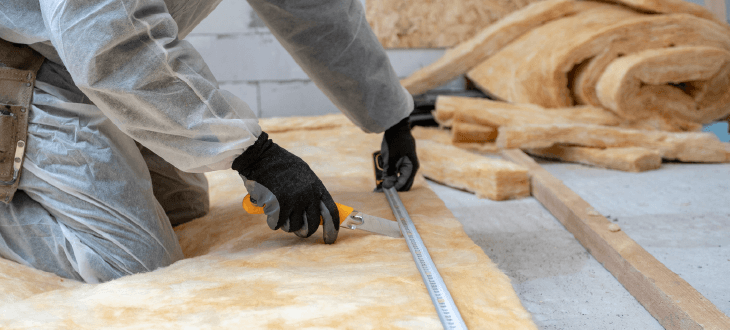
Insulation cost is just one factor to consider. Hiring a professional insulation company is crucial to ensuring your needs are met properly. It will also ensure compliance with government-set regulations and a professionality that will keep your home insulated without issues for decades to come.
However, finding reliable installers can be a challenging task. To help you make the best decision for your home, here are some key points to consider:
- Grant eligibility: Before reaching out to installers, check if you qualify for existing government grants. Two active initiatives - the Great British Insulation Scheme and the ECO4 scheme - aid low-efficiency and low-income homes in upgrading their insulation.
- PAS 2030 compliance: If you qualify for a government grant, choose an insulation specialist with PAS 2030/2035 approval, a government standard for grant-specific installers. This makes sure the job carried out by the insulation company is professional, and it is advised to look out for such installers even if you don’t qualify for a grant.
- Installer qualifications: Some insulation projects (especially exterior) may require planning permission and approval. Therefore, make sure to ask installers if they are a member of a competent person scheme related to insulation. Two popular examples of such schemes in the UK include CIGA and Stroma.
- Identify dishonest companies: Gathering quotes from various installers can help you understand the ballpark costs better. Be wary of pushy representatives asking for upfront payments without a job at hand, as these insulation companies might be part of a scam.
Understandably, keeping an eye out for all these details when sifting through endless installer sites can be an overwhelming task. Here at Household Quotes UK, we want to take this burden off your shoulders by linking you with our network of trusted installers right in your area.
All you have to do is fill out our 30-second form, and you can receive up to 3 quotes tailored to your budget and specific home needs. Best part? Our services are completely free of costs and obligations. Get ahead of the market by clicking on the link below!
- Describe your needs
- Get free quotes
- Choose the best offer
It only takes 30 seconds



Insulating your house by yourself
For those handy with DIY projects who would like to tackle home insulation by themselves, there are certainly some things you can do! However, it’s important to know your limits as most insulation tasks require stringent compliance with regulations, involve complex preparations, and work with potentially dangerous materials and tools.
There are some DIY-friendly insulation jobs that you can try your hand in:
- Loft insulation: Add mineral wool (rock or glass), or a similar fibrous insulator between the joists of your loft, leaving about 50mm space between the insulation material and floorboards for ventilation. Aim for 270mm thickness and use "loft legs” for support. Make sure to not block any existing ventilation shafts or air bricks.
- Floor insulation: With suspended timber floors, you can lift your floorboards and place 270mm of mineral wool (or a similar fluffy insulator) between the joists and secure them with netting before replacing the floorboards. Make sure not to compress the mineral wool as this will affect its ability to insulate.
- Draft-proofing: Seal up window and door gaps with adhesive strips or brushes that can be found in any local hardware store. You can also find draft covers for keyholes and chimneys, both online and in some hardware stores.
- Sealing leaks: Fill in the cracks in floors, walls, windows, and doors with silicone-based fillers or mastic-style fillers. Hardware stores have purpose-made applicator guns you can buy to make the job easier and more streamlined.
Insulation grants in the UK
To curtail fuel poverty and become carbon-neutral by 2050, the UK is placing serious attention on the dwindling energy efficiency of housing in the country. A series of insulation grants and energy efficiency schemes have been rolled out to assist low-income and low-efficiency households in upgrading their existing home and building insulation.
Homeowners who qualify for these schemes can receive whole or in-part assistance with the purchase and installation of home insulation upgrades and other energy solutions.
The Great British Insulation Scheme
This initiative targets the least energy-efficient homes in the UK to combat fuel poverty by providing a single insulation measure per household, tailored to their needs. This is because the scheme wants to maximize its outreach across the UK as much as possible.
2 main qualifiers that can benefit from this scheme are; the general eligibility group, and the low-income group and social housing group. Each group has further eligibility requirements:
| General eligibility group | Low-income and social housing group |
|---|---|
Homeowners who fall into: Council tax bands A-D in England. Council tax bands A-E in Scotland. Council tax bands A-E, with a SAP rating of D in Wales. | Homeowners on benefits such as: Allowance Child Benefit Child Tax Credit Guarantee Credit Housing Benefit Income-based Jobseekers Allowance Income-related Employment & Support Income Support Pension Credit Savings Credit Universal Credit Working Tax Credit |
Homeowners who qualify for the Great British Insulation Scheme can receive improvements to one type of insulation: cavity walls, lofts, solid walls, pitched roofs, flat roofs, under-floors, solid floors, park homes, and rooms in lofts!
ECO4
ECO4 offers grants for energy-efficient home upgrades in general, not just insulation-related. The scheme emphasizes the need to reduce domestic carbon emissions, energy consumption, and fuel poverty across the UK.
It does so by placing a Home Heating Cost Reduction Obligation (HHCRO) on medium to large energy suppliers in the UK, who are then obliged to provide certain measures, including house insulation to low-income and fuel-poor households.
If you're ready for big bill savings and an energy-efficient home, you might be looking for the right installer. This is easier said than done, as researching can have you sifting through endless websites and calls for hours on end. Let Household Quotes UK take care of the heavy work for you!
Simply fill out our 30-second form, and receive up to 3 free home-tailored quotes from our network of trusted local installers; no obligations attached. Get ahead of the market prices with the best bargains and make sure your home gets the highest quality, budget-friendly insulation available.
- Describe your needs
- Get free quotes
- Choose the best offer
It only takes 30 seconds



FAQ
The cheapest insulation available would be insulating your pipes, radiators, and water tank. This naturally brings smaller savings compared to some larger insulation upgrades, so an effective suggestion is to implement piping insulation alongside more impactful upgrades, such as to your walls, floors, and loft.
R-value is a score for how well a material resists heat flow. The higher a material’s R-value, the better it is at insulating your home. U-value measures the rate of heat transfer through a material. Therefore, the lower the U-value, the slower the rate of heat transfer, thus making the material a good insulator.
Loft or floor insulation tasks can be performed DIY, provided that you adhere to government regulations. You can also draught-proof your home with some easy heat-saving tips. When insulating, it is best to work with a professional accredited installer to make sure the job is done correctly and your home remains properly insulated for decades to come.
In the UK, cavity wall insulation is a common insulation method for properties generally built after the 1920’s. This is when the gap or ‘cavity’ between the inner and outer walls of a property is filled with insulating material. This can slash up to one-third of a home’s heat loss.
Cellulose is considered one of the, safest, affordable, and non-toxic insulation materials on the market. Made from recycled paper products and/or plant material, it is a fibrous shredded material that can be blown and tightly packed into cavity walls and floors.
Several other eco-friendly insulation materials are just as safe and sustainable to use.

Akif has a keen interest in green home improvement solutions and the role of digital media in identifying climate trends. He aims to provide a multidisciplinary approach to content rooted in credible research and accuracy.
